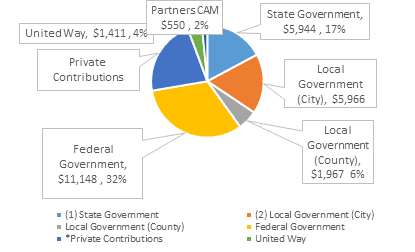“More than a shelter, it’s a transformational campus.” That’s Haven for Hope’s slogan. Open since 2010, they are an organization located in San Antonio addressing homelessness.
In August, The Dallas Express interviewed the interim president and CEO Molly Biglari about their work and results.
“The downtown homeless count has decreased by 77 percent since 2010,” she said. “That is one of the biggest visual impacts of having Haven is the downtown count.”
They also help get the homeless into housing, and Biglari reported their current retention are of clients staying in homes after a year is 93 percent.
Goals, Funding, and Model
Multiple charities’ efforts are concentrated at Haven, providing healthcare, housing, job assistance, ID recovery, and more. “We operate in conjunction with about 180 partners, 70 of whom are on our campus on a regular basis,” Biglari said.
What are Haven’s goals? “To help as many clients as we can,” Biglari replied.
She provided a pie chart of Haven’s sources of funding.

She said during COVID, “a lot of agencies have gotten extra housing money last year.” “Our goal is to spend all that money appropriately on our clients.” She explained they “certainly do an excellent job at tracking it and reporting on it.”
Biglari described Haven’s model as “person-centered trauma-informed care.” “We sit down with that individual, and we identify what those barriers are [for them], and we have a goal of housing.”
Homeless are led to Haven by outreach programs from the city and other agencies, building trust over time individually. “When that person says, ‘I’m ready for services,’ either they transport them to Haven, or we’ll go and pick them up.”
The Homeless
Biglari said “probably 85 percent” of their clients have a “mental health challenge,” some severe, “about 20 percent” escaping domestic violence, and 10 percent are “chronically homeless.”
She expects Haven there will be more homeless soon. “The real estate rents are definitely going up, and people are being priced out and losing their homes,” Biglari said. “You throw in COVID and the eviction moratorium, and that people are going to be coming out of that once it’s lifted, we expect to see a huge number of folks who are going to need services across the board.”
The Dallas Express found homeless residing in tents across Dallas. We asked Biglari about homeless encampments. “We do not think it’s an effective solution,” she said. “We feel that when people are settled in an encampment, that they’re missing out on the services, they can have to get to a better place.”
“You have a right to be homeless, but we don’t think that that relegates you to a life without services and without getting to a better place.”
She explained homeless encampments aren’t allowed in downtown San Antonio, but no one is forced to come to Haven.
Duplicating Haven for Hope
“I think the model is duplicative anywhere,” Biglari said. But not exactly. “We happen to be on 22 acres in downtown San Antonio, just west of downtown. That part is very difficult to duplicate in other cities.”
“We don’t ever tell anyone what we do is the right way to do it, but we know what we do works, and it works for our community,” Biglari said. “Our advice, number one learning from this model, if nothing else [is] that collaboration really works.”
She emphasized it hinges on collaboration. “You want to include as many partners as you can to knock down every barrier, but you don’t have to all be co-located,” she said.


